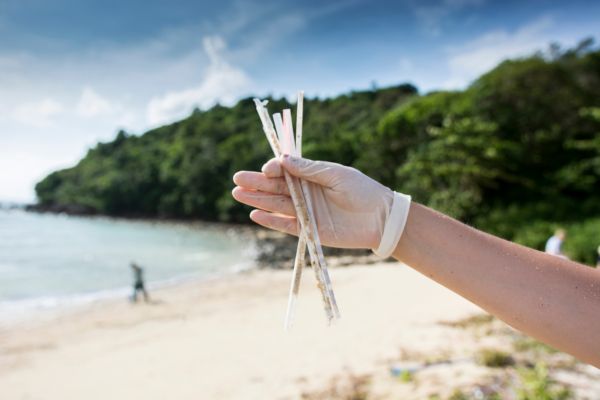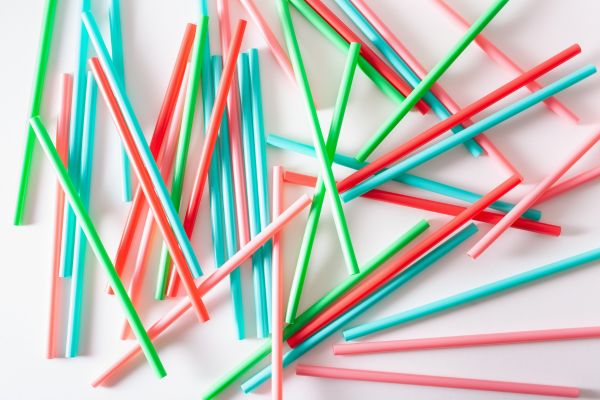Plastic straws have become a symbol of the broader issue of single-use plastics and their environmental impact. While they may seem like small and inconsequential items, plastic straws pose a significant threat to our planet for several key reasons.
In this post, we will explore the question, “are plastic straws bad for the environment?”. This will help you understand the environmental consequences associated with plastic straws and what you can do about it.
How Bad Are Straws For The Environment
The effects of something as basic as a plastic straw are widespread, and unfortunately, they are representative of most single-use plastics. When discarded, they can remain intact for hundreds of years, contributing to long-lasting pollution. They accumulate in landfills, litter streets, and usually end up polluting the oceans.
Here are some of the issues:
Plastic straws don’t biodegrade
Plastic straws are predominantly made from polypropylene, a type of plastic that does not readily biodegrade. Plus, the production of plastic straws also consumes significant amounts of resources. Polypropylene, or plastic number 5, is made from fossil fuels. The extraction and processing of these resources for plastic production have environmental consequences, including habitat destruction, water pollution, and greenhouse gas emissions.
Straws pollute marine environments and endanger wildlife
One of the most significant threats associated with plastic straws is their impact on marine ecosystems. Plastic straws are lightweight and easily carried by the wind, rivers, and stormwater runoff into water bodies and ultimately end up in the ocean. One of the most significant dangers of plastic straws is the effects on marine life.
Marine animals, particularly sea turtles, seabirds, and marine mammals, often mistake plastic straws for food. When ingested, straws can cause physical harm and blockages in the digestive system. The consumption of plastics can result in malnutrition, starvation, and sometimes death. This poses a severe threat to marine biodiversity, as these animals are essential to the delicate balance of marine ecosystems.

Microplastic Generation resulting from discarded straws
Plastic straws, over time, break down into smaller and smaller pieces due to exposure to the sun, waves, and mechanical forces. These tiny plastic fragments, known as microplastics, are a pervasive problem in the environment.
Microplastics are less than 5mm in size and can be found in water bodies, soils, and even in the air. They are known to cause a wide range of environmental issues. In addition to the harm they can cause wildlife, they can absorb and transport toxic chemicals. When ingested by marine organisms, these toxic chemicals can enter the food chain, posing risks to human health.
Litter and Aesthetics
Plastic straws are often littered in public spaces. They are commonly found on beaches, in parks, and along roadsides. This litter not only detracts from the beauty of these areas but also has consequences. Littered plastic straws can be ingested by wildlife, as discussed earlier, but they can also pose a danger to domestic animals, such as pets and livestock. Moreover, cleaning up plastic litter is costly and often falls on local governments and communities, diverting resources that could be better used elsewhere.
Plastic straws are difficult to Recycle
Recycling plastic straws can be challenging due to their small size, lightweight nature, and the fact that they are often contaminated with food and beverage residues. Many recycling facilities are not equipped to process and separate such small and flimsy items efficiently. As a result, most plastic straws are not accepted by curbside recycling and do not end up being recycled. Instead, they are sent to landfills or incinerated.
Although recycling plastic straws is not possible, many other plastic items can be recycled into new recycled plastic products. Why not take a look at our recycled products guides to see what waste plastic can be turned into?
Reducing the Threat of Plastic Straws
In the early 2000s, concerns began to surface about the environmental impact of single-use plastics, including plastic straws. In the mid-2010s, the issue gained substantial traction, thanks in part to viral social media posts showcasing the harm caused by plastic straws to marine life.
This growing awareness led to the implementation of plastic straw bans in various cities and regions, inspiring the rise of grassroots activism and campaigns urging individuals, businesses, and governments to reduce their use of plastic straws.
It’s essential we take meaningful steps to mitigate the impacts of plastic straws and single-use plastics. The most effective way for us to reduce the threat of plastic straws is to use fewer of them. Individuals can simply refuse straws when they are unnecessary or opt for alternatives like reusable metal or bamboo straws. Why not pledge to skip the straw today?
If you do use plastic straws, make sure to dispose of them responsibly. Follow local recycling guidelines and avoid littering to prevent straws from entering the environment.
Alternatives to plastic straws
Thanks to activism in the last decade or so, there are now many alternatives to plastic drinking straws.
Biodegradable straws
Options for biodegradable straws include more natural materials that can break down safely without any toxic pollutants, and some are even edible. Examples of biodegradable straws include:
- Paper Straws: made from food-grade paper and coated with a thin layer of wax or plant-based materials to make them moisture-resistant.
- Bamboo Straws: Bamboo straws are crafted from bamboo stalks, making them a sustainable and biodegradable option. They are reusable and can last for an extended period with proper care.
- Wooden Straws: Wooden straws are typically made from sustainably sourced wood, such as birch or beech.
- Edible Pasta Straws: Pasta straws, often made from wheat or rice, are edible and biodegradable.
Reusable straws
In addition to the many biodegradable alternatives for plastic straws, there are many reusable options. Using a reusable straw can significantly reduce your environmental footprint and contribute to the global effort to minimize single-use plastic waste. Here are just a few available types:
- Metal Straws: These are typically made from stainless steel, copper, aluminum, or titanium. They are durable, long-lasting, and resistant to rust and corrosion.
- Glass Straws: Glass straws are made from high-quality borosilicate glass that is resistant to thermal shock.
- Silicone Straws: Silicone straws are soft, flexible, and safe to use.
- Plastic Reusable Straws: While the goal is to reduce single-use plastic, some reusable straws are made from high-quality, food-grade plastic materials intended to last.
Plastic straws may seem like a small and insignificant item, but their widespread use and improper disposal have had and still have significant environmental consequences. Beyond the specific environmental impacts of plastic straws, their production and disposal contribute to the broader problem of plastic pollution. Plastic waste is a global issue with severe environmental consequences, including the degradation of ecosystems, disruption of natural processes, and harm to wildlife.
Individual choices, such as saying no to straws or choosing reusables, have a real impact in addressing these environmental challenges.
You have the potential to help bring about change!














